Influence of Explosive Ratio on Morphological and Structural Properties of Ti/Al Clads
Abstract
1. Introduction
2. Experimental Materials and Methods
3. Results and Discussion
3.1. Microstructure Investigation
3.2. Mechanical Tests
4. Conclusions
Author Contributions
Funding
Acknowledgments
Conflicts of Interest
References
- Kahraman, N.; Gülenç, B.; Findik, F. Joining of titanium/stainless steel by explosive welding and effect on interface. J. Mater. Process. Technol. 2005, 169, 127–133. [Google Scholar] [CrossRef]
- Zu, G.Y.; Sun, X.; Zhang, J.H. Interfacial bonding mechanism and mechanical performance of Ti/Steel bimetallic clad sheet produced by explosive welding and annealing. Rare Met. Mater. Eng. 2017, 46, 906–911. [Google Scholar]
- Manikandan, P.; Hokamoto, K.; Fujita, M.; Raghukandan, K.; Tomoshige, R. Control of energetic conditions by employing interlayer of different thickness for explosive welding of titanium/304 stainless steel. J. Mater. Process. Technol. 2008, 195, 232–240. [Google Scholar] [CrossRef]
- Honarpisheh, M.; Asemabadi, M.; Sedighi, M. Investigation of annealing treatment on the interfacial properties of explosive-welded Al/Cu/Al multilayer. Mater. Des. 2012, 37, 122–127. [Google Scholar] [CrossRef]
- Li, Y.J. The Welding Technology of Advanced Materials, 1st ed.; Chemical Industry Press: Beijing, China, 2012; pp. 1–489. [Google Scholar]
- Findik, F. Recent developments in explosive welding. Mater. Des. 2011, 32, 1081–1093. [Google Scholar] [CrossRef]
- Guo, X.Z.; Fan, M.Y.; Liu, Z.L.; Ma, F.Y.; Wang, L.; Tao, J. Explosive cladding and hot pressing of Ti/Al/Ti laminates. Rare. Met. Mater. Eng. 2017, 46, 1192–1196. [Google Scholar]
- Vecchio, K.S. Synthetic multifunctional metallic–intermetallic laminate composites. JOM 2005, 57, 25–31. [Google Scholar] [CrossRef]
- Peng, L.M.; Wang, J.H.; Li, H.; Zhao, J.H.; He, L.H. Synthesis and microstructural characterization of Ti–Al3Ti metal–intermetallic laminate (MIL) composites. Scr. Mater. 2005, 52, 243–248. [Google Scholar] [CrossRef]
- Akca, E.; Gursel, A. The Effect of Diffusion Welding Parameters on the mechanical properties of Titanium alloy and Aluminum couples. Metals. 2017, 7, 22. [Google Scholar] [CrossRef]
- Kahraman, N.; Gulenc, B.; Findik, F. Corrosion and mechanical-microstructural aspects of dissimilar joints of Ti–6Al–4V and Al plates. Int. J. Impact Eng. 2007, 34, 1423–1432. [Google Scholar] [CrossRef]
- Lysak, V.I.; Kuzmin, S.V. Energy balance during explosive welding. J. Mater. Process. Technol. 2015, 222, 356–364. [Google Scholar] [CrossRef]
- Chen, Y.C.; Nakata, K. Microstructural characterization and mechanical properties in friction stir welding of aluminum and titanium dissimilar alloys. Mater. Des. 2009, 30, 469–474. [Google Scholar] [CrossRef]
- Vaidya, W.; Horstmann, M.; Ventzke, V.; Petrovski, B.; Koçak, M.; Kocik, R.; Tempus, G. Improving interfacial properties of a laser beam welded dissimilar joint of aluminium AA6056 and titanium Ti6Al4V for aeronautical applications. J. Mater. Sci. 2010, 45, 6242–6254. [Google Scholar] [CrossRef]
- Nayak, S.S.; Pabi, S.K.; Kim, D.H.; Murty, B.S. Microstructure-hardness relationship of Al–(L12)Al3Ti nanocomposites prepared by rapid solidification processing. Intermetallics. 2010, 18, 487–492. [Google Scholar] [CrossRef]
- Abbasi Chianeh, V.; Madaah Hosseini, H.R.; Nofar, M. Micro structural features and mechanical properties of Al–Al3Ti composite fabricated by in-situ powder metallurgy route. J. Alloys Compd. 2009, 473, 127–132. [Google Scholar] [CrossRef]
- Xia, H.B.; Wang, S.G.; Ben, H.F. Microstructure and mechanical properties of Ti/Al explosive cladding. Mater. Des. 2014, 56, 1014–1019. [Google Scholar] [CrossRef]
- Bataev, I.A.; Bataev, A.A.; Mali, V.I.; Pavliukova, D.V. Structural and mechanical properties of metallic-intermetallic laminate composites produced by explosive welding and annealing. Mater. Des. 2012, 35, 225–234. [Google Scholar] [CrossRef]
- Foadian, F.; Soltanieh, M.; Adeli, M.; Adeli, M.; Etminanbakhsh, M. A study on the formation of intermetallics during the heat treatment of explosively welded Al-Ti multilayers. Metall. Mater. Trans. A. 2014, 45, 1823–1832. [Google Scholar] [CrossRef]
- Fronczek, D.M.; Wojewoda-Budka, J.; Chulist, R.; Sypien, A.; Korneva, A.; Szulc, Z.; Schell, N.; Zieba, P. Structural properties of Ti/Al clads manufactured by explosive welding and annealing. Mater. Des. 2016, 91, 80–89. [Google Scholar] [CrossRef]
- Li, Y.; Liu, C.; Yu, H.; Zhao, F.; Wu, Z. Numerical simulation of Ti/Al bimetal composite fabricated by explosive welding. Metals 2017, 7, 407. [Google Scholar] [CrossRef]
- Liu, R.; Wang, W.; Zhang, T.; Yuan, X. Numerical study of Ti/Al/Mg three-layer plates on the interface behavior in explosive welding. Sci. Eng. Compos. Mater. 2016, 24, 833–843. [Google Scholar] [CrossRef]
- Shi, C.G.; Wang, Y.; Li, S.J.; You, J. Application and experiment on the least-action principle of explosive welding of stainless steel/steel. J. Iron Steel Res. Int. 2014, 21, 625–629. [Google Scholar] [CrossRef]
- Shi, C.G.; Wang, Y.; Zhao, L.S.; Hou, H.B.; Ge, Y.H. Detonation mechanism in double vertical explosive welding of stainless steel/steel. J. Iron Steel Res. Int. 2015, 22, 949–953. [Google Scholar] [CrossRef]
- Lysak, V.I.; Kuzmin, S.V. Lower boundary in metal explosive welding. Evolution of ideas. J. Mater. Process. Technol. 2012, 212, 150–156. [Google Scholar] [CrossRef]
- Vaidyanathan, P.V.; Ramanathan, A. Computer-aided design of explosive welding systems. J. Mater. Process. Technol. 1993, 38, 501–516. [Google Scholar] [CrossRef]
- Zhen, Y.M. The Principle and Application of Explosive Welding and Metallic Composite, 1st ed.; Central South University Press: Changsha, China, 2007; pp. 1–143. [Google Scholar]
- Yoshida, M.; Iida, M.; Tanaka, K.; Fujiwara, S.; Kusakabe, M.; Kusakabe, K. Detonation behavior of emulsion explosives containing glass microballoons. In Proceedings of the 8th International Symposium on Detonation, Albuquerque, NM, USA, 15–19 July 1985; pp. 171–177. [Google Scholar]
- Shao, B.H.; Zhang, K. Explosive Welding Principle and Its Application, 1st ed.; Dalian University of Science and Technology Press: Dalian, China, 1987; pp. 1–387. [Google Scholar]
- Akbari Mousavi, S.A.A.; Farhadi Sartangi, P. Experimental investigation of explosive welding of cp-titanium/AISI 304 stainless steel. Mater. Des. 2009, 30, 459–468. [Google Scholar] [CrossRef]
- Wronka, B. Testing of explosive welding and welded joints. Wavy character of the process and joint quality. Int. J. Impact Eng. 2011, 38, 309–313. [Google Scholar] [CrossRef]
- Acarer, M.; Gülenç, B.; Findik, F. Investigation of explosive welding parameters and their effects on microhardness and shear strength. Mater. Des. 2003, 24, 659–664. [Google Scholar] [CrossRef]
- Li, Y.; Wu, Z.S. Microstructural characteristics and mechanical properties of 2205/AZ31B laminates fabricated by explosive welding. Metals 2017, 7, 125. [Google Scholar] [CrossRef]
- Schuster, J.C.; Palm, M. Reassessment of the binary Aluminum-Titanium phase diagram. J. Phase Equilib. Diff. 2006, 27, 255–277. [Google Scholar] [CrossRef]
- Dodd, B.; Walley, S.M.; Yang, R.; Nesterenko, V.F. Major steps in the discovery of adiabatic shear bands. Metall. Mater. Trans. A 2015, 46, 4454–4458. [Google Scholar] [CrossRef]
- Zhang, N.; Wang, W.; Cao, X.; Wu, J. The effect of annealing on the interface microstructure and mechanical characteristics of AZ31B/AA6061 composite plates fabricated by explosive welding. Mater. Des. 2015, 65, 1100–1109. [Google Scholar] [CrossRef]
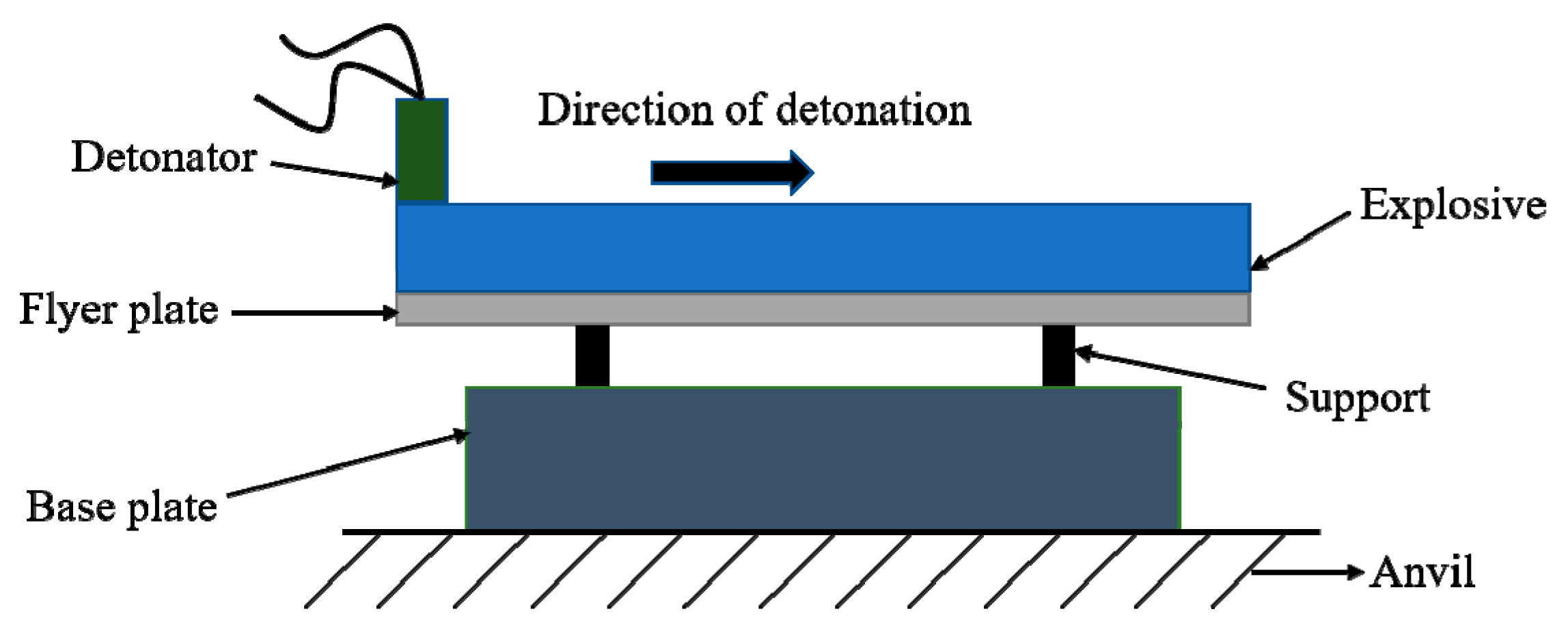
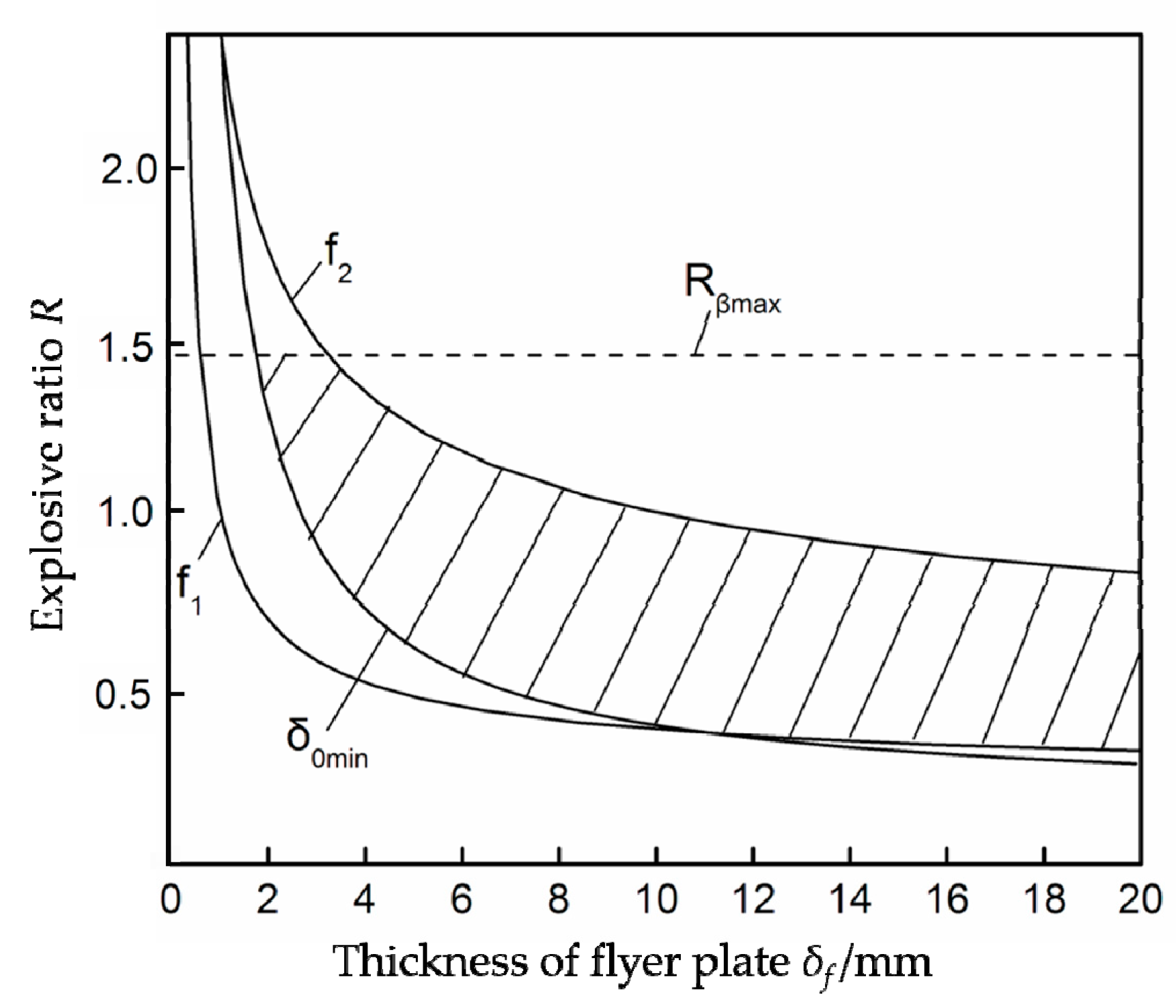
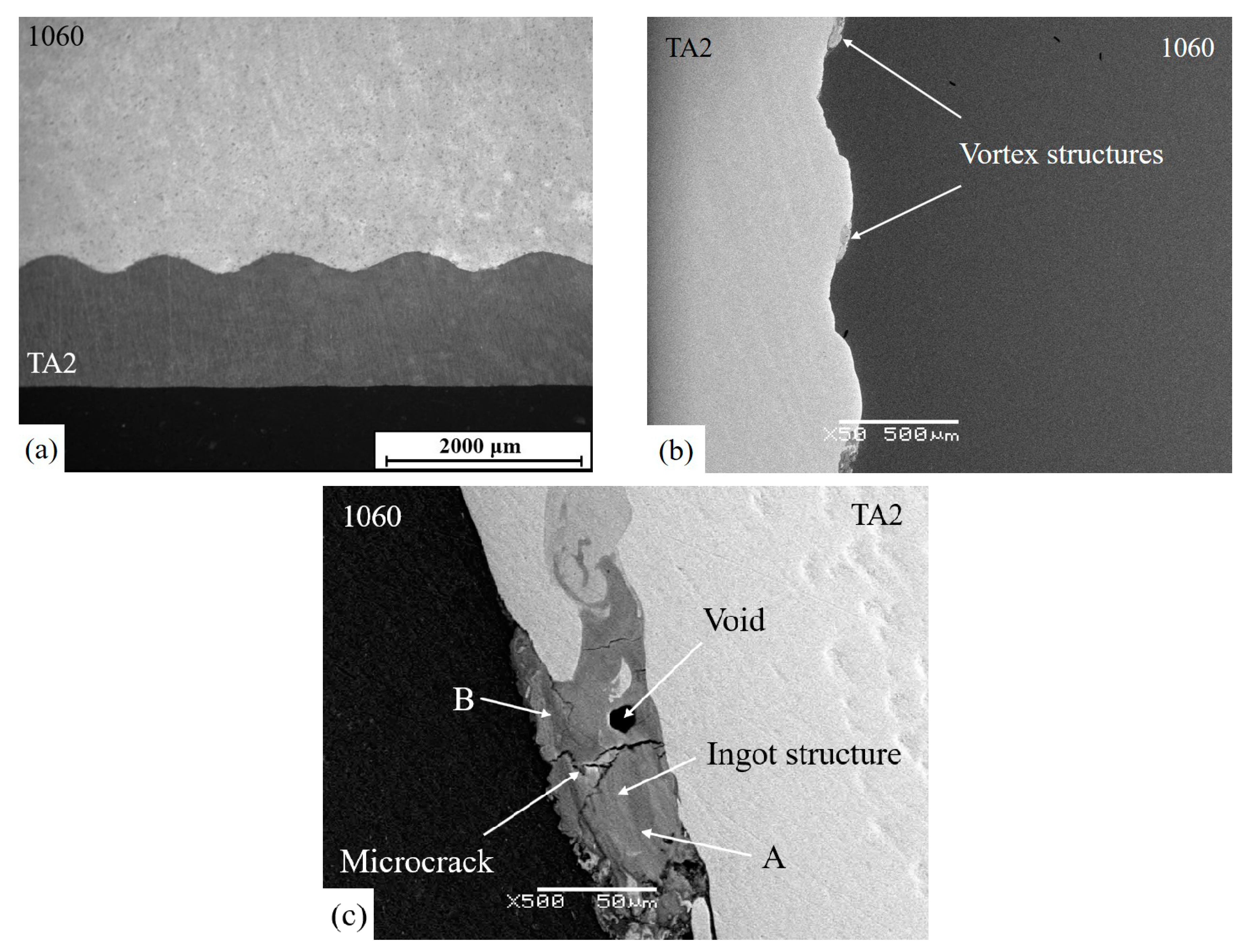
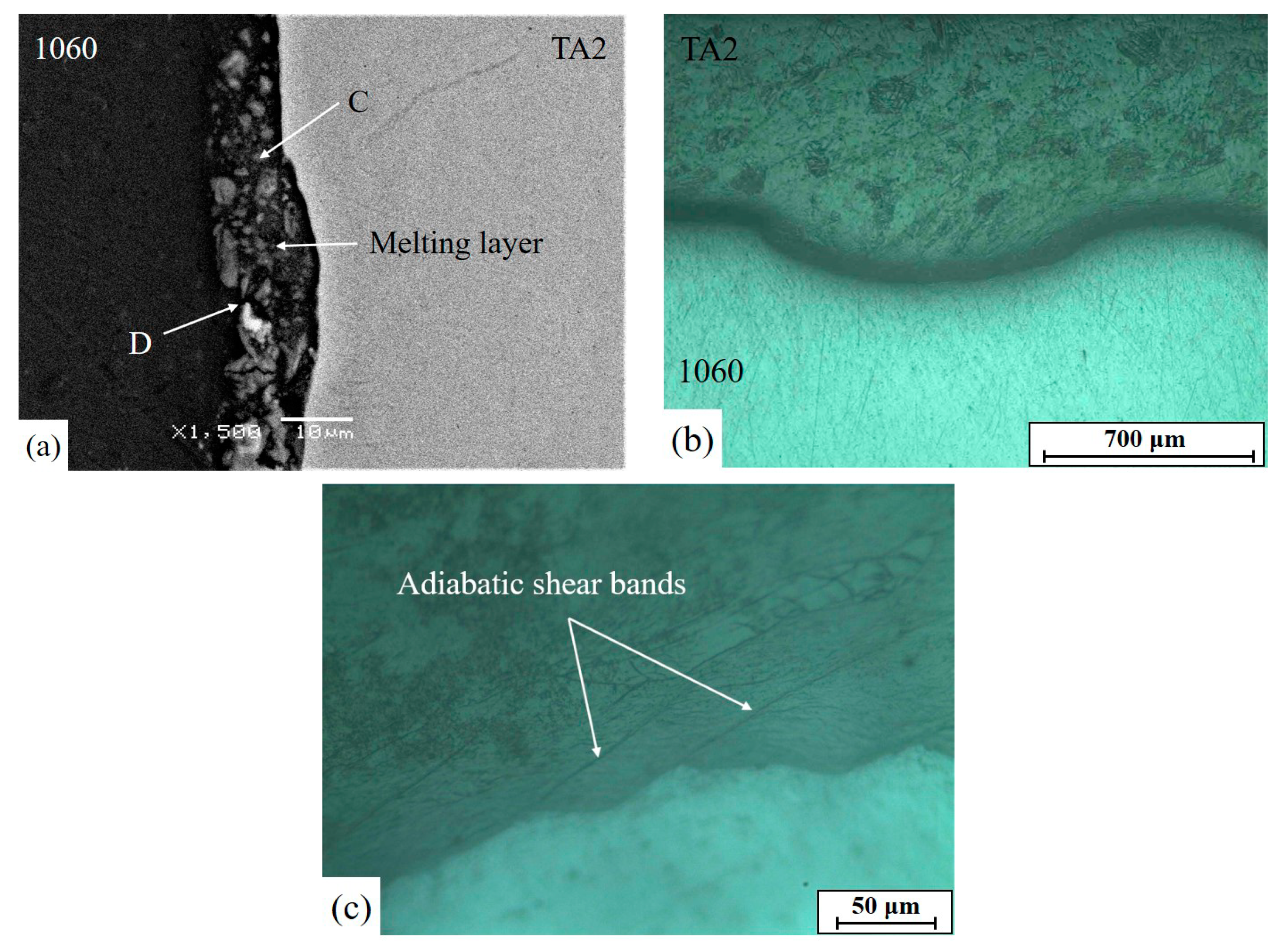
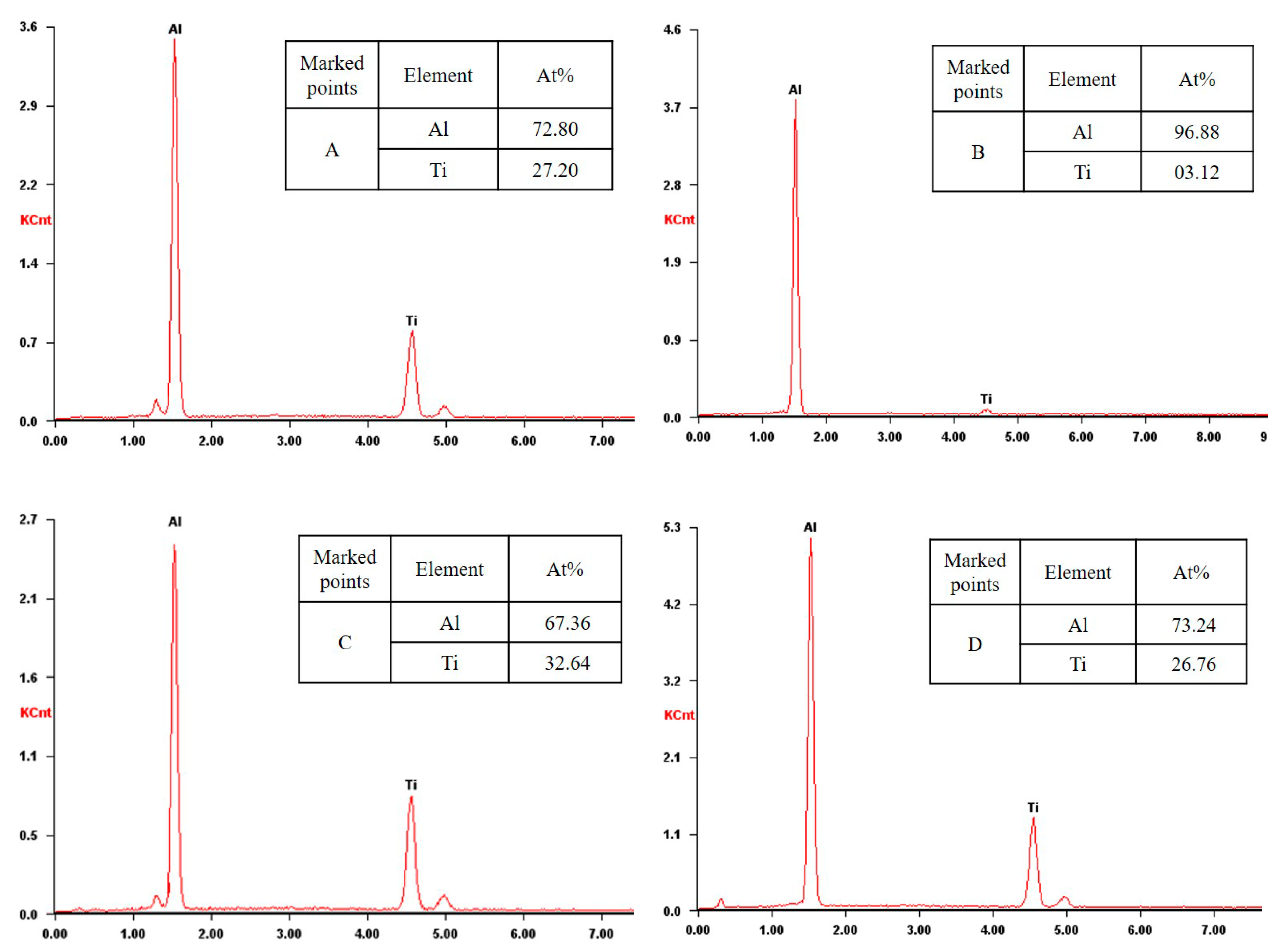
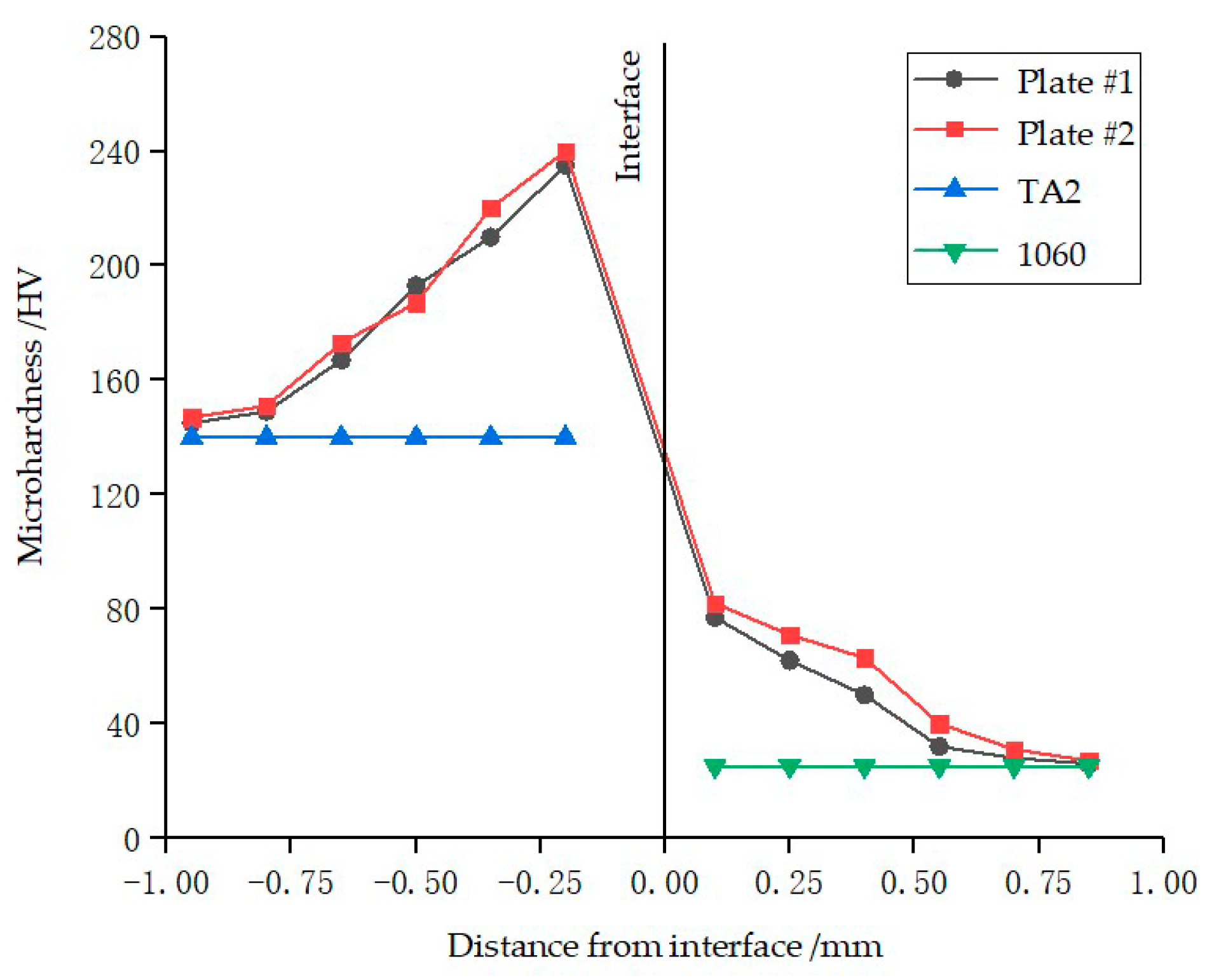

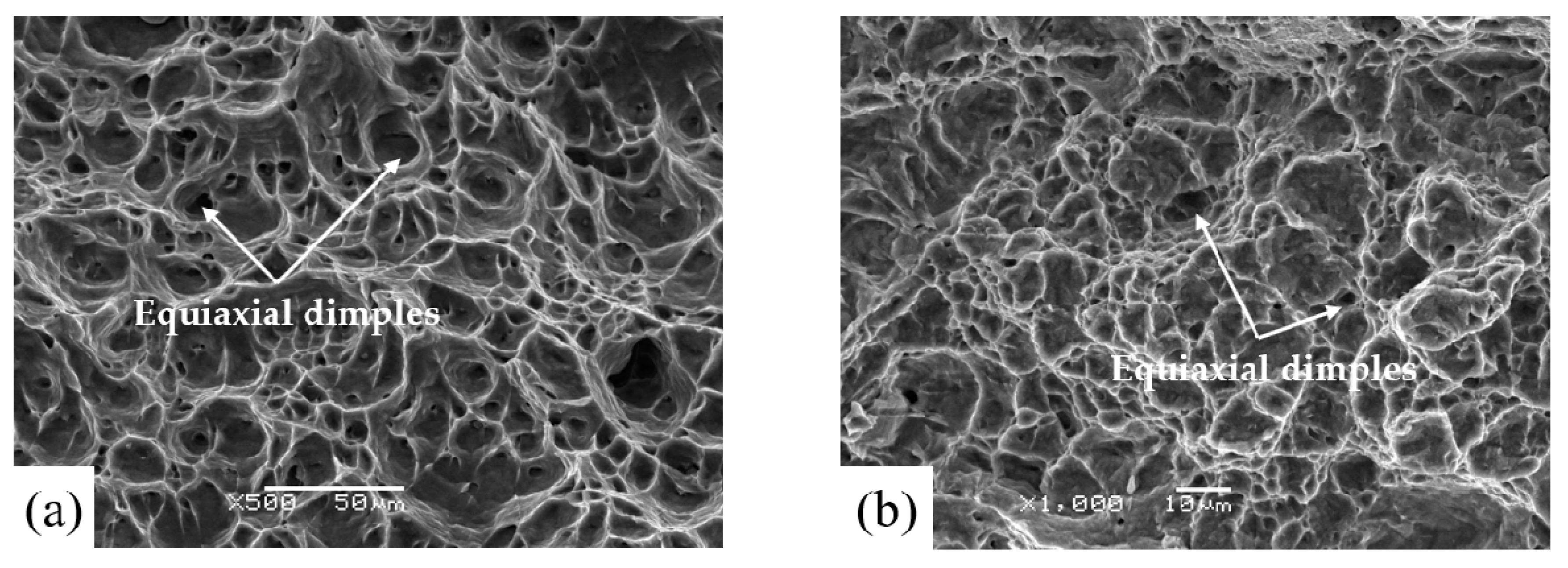
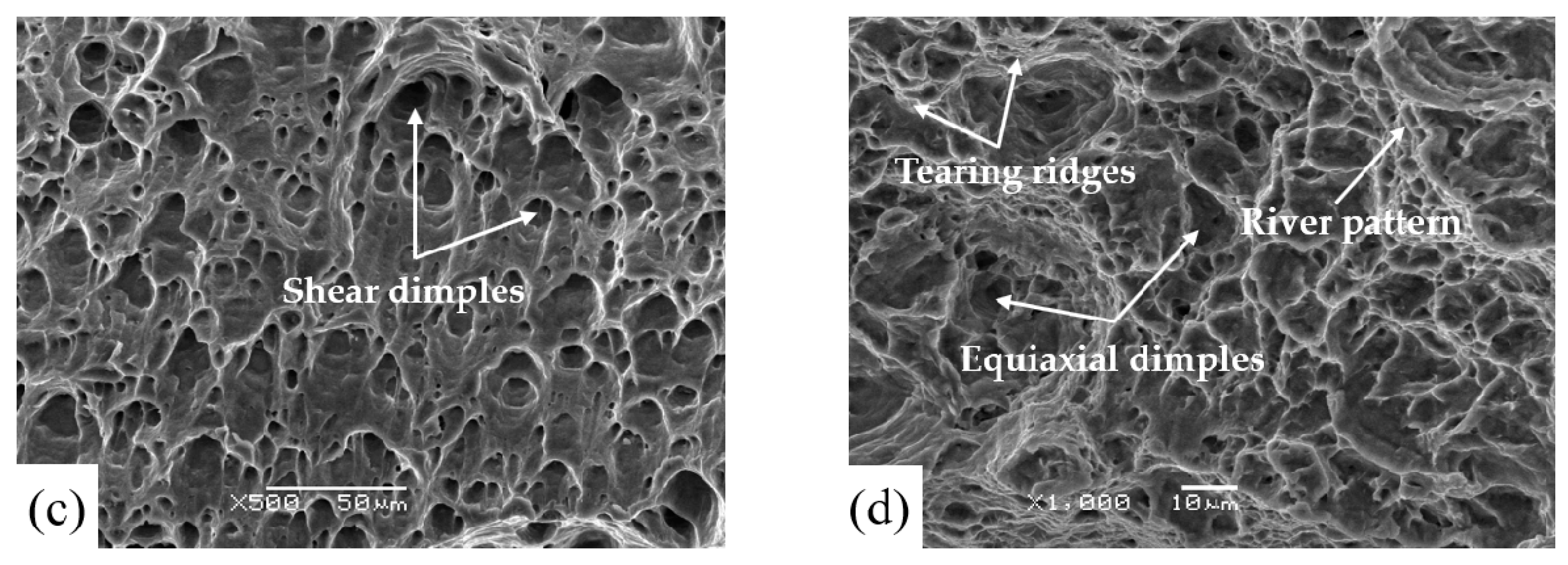
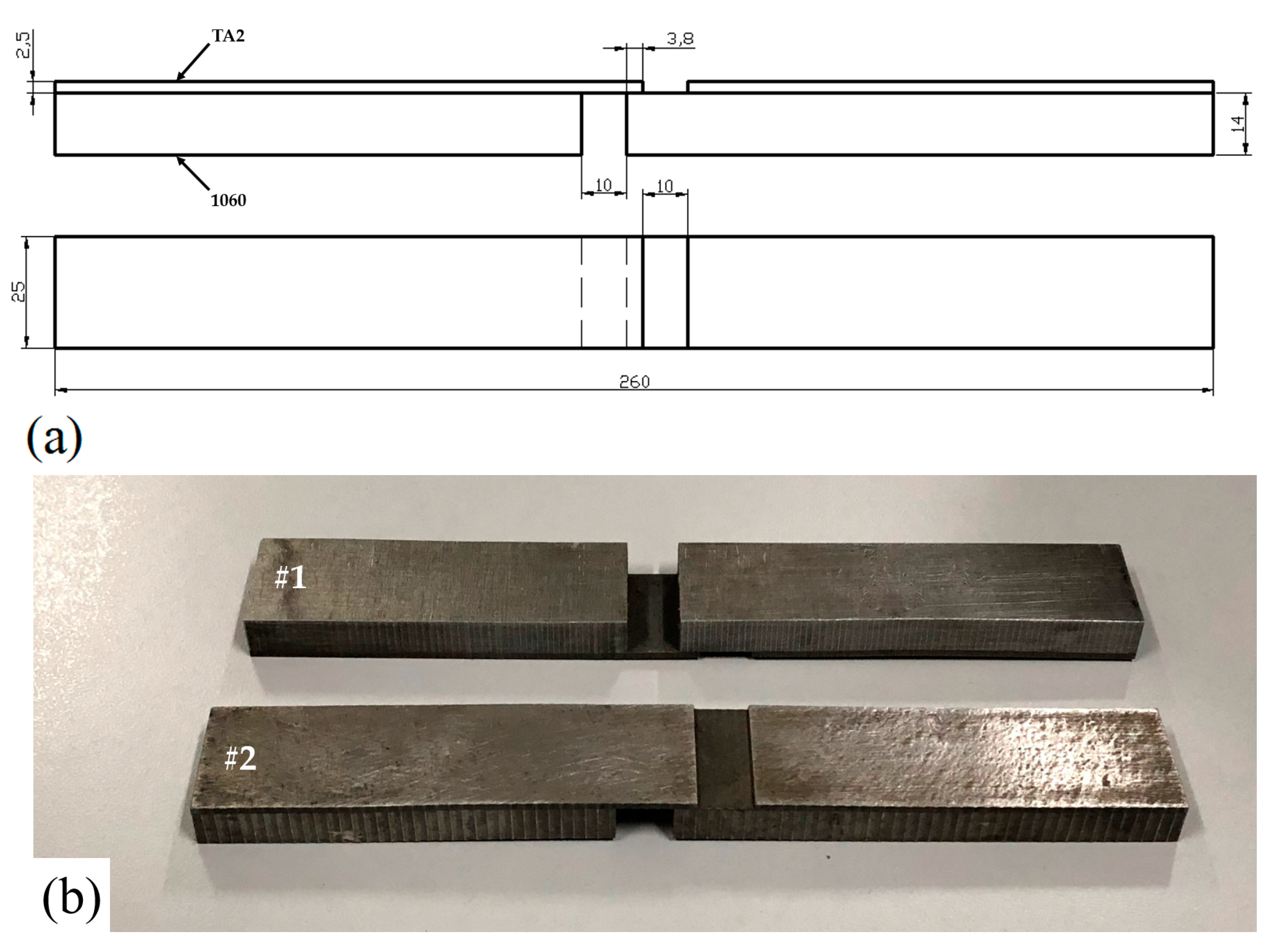
| Materials | Chemical Composition (≤%) | |||||||
|---|---|---|---|---|---|---|---|---|
| TA2 | Fe | Si | C | N | O | H | Ti | - |
| 0.3 | 0.15 | 0.1 | 0.05 | 0.2 | 0.015 | Balanced | - | |
| 1060 | Fe | Si | Cu | Mn | Mg | Zn | Ti | Al |
| 0.35 | 0.25 | 0.05 | 0.03 | 0.03 | 0.05 | 0.03 | Balanced | |
| Tested Plate | δ0/mm | Interface Morphology | λ/μm | A/μm | Diffusion Area/μm | Microstructure | ||
|---|---|---|---|---|---|---|---|---|
| Vortex Structure | Melting | ASB | ||||||
| sample 1 | 14 | Small wave | 850–1100 | 120–140 | 5.2 | Regular appearance | Ingot structure | Few |
| sample 2 | 21 | Big wave and melting layer | 1550–1700 | 230–280 | 9.5 | Few | Melting layer | Many |
| Tested Plate | Tensile Strength/MPa | Elongation/% |
|---|---|---|
| sample 1 | 209.4 | 21.3 |
| sample 2 | 217.5 | 20.4 |
© 2019 by the authors. Licensee MDPI, Basel, Switzerland. This article is an open access article distributed under the terms and conditions of the Creative Commons Attribution (CC BY) license (http://creativecommons.org/licenses/by/4.0/).
Share and Cite
Fang, Z.; Shi, C.; Shi, H.; Sun, Z. Influence of Explosive Ratio on Morphological and Structural Properties of Ti/Al Clads. Metals 2019, 9, 119. https://doi.org/10.3390/met9020119
Fang Z, Shi C, Shi H, Sun Z. Influence of Explosive Ratio on Morphological and Structural Properties of Ti/Al Clads. Metals. 2019; 9(2):119. https://doi.org/10.3390/met9020119
Chicago/Turabian StyleFang, Zhonghang, Changgen Shi, Hesheng Shi, and Zerui Sun. 2019. "Influence of Explosive Ratio on Morphological and Structural Properties of Ti/Al Clads" Metals 9, no. 2: 119. https://doi.org/10.3390/met9020119
APA StyleFang, Z., Shi, C., Shi, H., & Sun, Z. (2019). Influence of Explosive Ratio on Morphological and Structural Properties of Ti/Al Clads. Metals, 9(2), 119. https://doi.org/10.3390/met9020119





